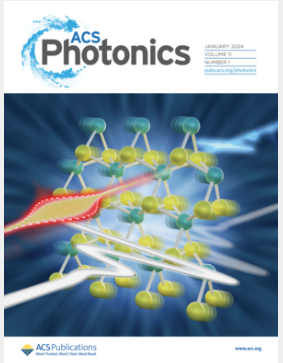泄漏导模诱导的大角度非局部超表面
IF 6.7
1区 物理与天体物理
Q1 MATERIALS SCIENCE, MULTIDISCIPLINARY
引用次数: 0
摘要
超表面可以通过局部模式操纵空间域中的光,是传统光学系统的超薄替代品。然而,用这种超表面实现大角度调制面临着巨大的挑战,比如效率降低。为了解决这个问题,引入了超聚光的概念,促进了具有高数值孔径或宽视场的设备的发展。非局部超表面具有非局部模式,在时域和空域控制光,由于模式退化和波长周期依赖,在实现大角度调制方面遇到了更大的困难,但目前还没有提出有效的解决方案。在这里,我们设计了一种方法来实现大角度的非局部超表面,通过诱导多个泄漏引导模式(lgm)使用最小微扰元原子阵列与波导板。设计了一种利用几何相位和附加光栅矢量以及lgm之间耦合实现光的空间和光谱调制的系统,该系统在极端偏转角度为79°时的质量因子和衍射效率分别为2.2 × 103和29%。这项研究在需要波长选择性大角度调制的系统中具有重要的应用潜力,例如增强现实和非局部谐波产生。本文章由计算机程序翻译,如有差异,请以英文原文为准。

Leaky Guided Mode-Induced Large-Angle Nonlocal Metasurfaces
Metasurfaces that can manipulate light in the spatial domain via local modes are an ultrathin alternative to conventional optical systems. However, achieving large-angle modulation with such metasurfaces presents significant challenges such as diminished efficiency. To address this, the concept of metagrating has been introduced, facilitating the development of devices with a high numerical aperture or wide field of view. Nonlocal metasurfaces, which possess nonlocal modes and control light in both the temporal and spatial domains, encounter even greater difficulties in achieving large-angle modulation due to mode degradation and wavelength-period dependency, but an effective solution has not been proposed yet. Here, we devised a method for realizing large-angle nonlocal metasurfaces by inducing multiple leaky guided modes (LGMs) using a minimally perturbed meta-atom array in conjunction with a waveguide slab. A system that achieves spatial and spectral modulation of light by leveraging the geometric phase with an additional grating vector and coupling between the LGMs is designed, and this system achieves a quality factor and diffraction efficiency of 2.2 × 103 and 29%, respectively, at an extreme deflection angle of 79°. This investigation holds significant potential for applications in systems requiring wavelength-selective large-angle modulation, such as augmented reality and nonlocal harmonic generation.
求助全文
通过发布文献求助,成功后即可免费获取论文全文。
去求助
来源期刊

ACS Photonics
NANOSCIENCE & NANOTECHNOLOGY-MATERIALS SCIENCE, MULTIDISCIPLINARY
CiteScore
11.90
自引率
5.70%
发文量
438
审稿时长
2.3 months
期刊介绍:
Published as soon as accepted and summarized in monthly issues, ACS Photonics will publish Research Articles, Letters, Perspectives, and Reviews, to encompass the full scope of published research in this field.
 求助内容:
求助内容: 应助结果提醒方式:
应助结果提醒方式:


